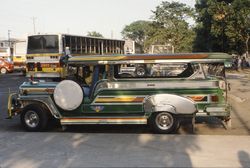Many things has been written and much has been said about the Philippine Jeepney and Tricycle. I guess that most readers have not experienced travelling in this form of local transportation first hand. I could not resist the temptation to give you my own perspective on these magnificent vehicles, a personal reflection, seen through the eyes of a spoiled, but open minded Westerner visiting the wonderful island of Mindanao.

 Jeepney
Jeepney
I’ve learned that the Jeepney is one of the most popular means of public transportation in the Philippines, a unique way of travelling. It was originally made from leftover US military jeeps which in time became a symbol of Philippine culture.
My first impression was that most jeepneys are festively decorated and are often named after biblical characters. Every single Philippine jeepney is personalized; no jeepney is exactly the same as another. These undisputed "kings of the road" are famous for their colorful illustrations, bright colours and notorious for their crowded seating and horn-blowing drivers. I also found out that these drivers can be, most of the time, an amusement to their passengers and the best guides one can find in any part of Mindanao.
It was clear to see that the jeepney is very popular, the seats inside were often filled with passengers and their belongings. On every trip I was seated face-to-face and knee to knee, my personal space was minimized to almost nothing. However, to my surprise, always new passengers were added to the already overcrowded cabin. Mindanaoans are flexible and creative people. They will still get on board, eager to start the journey to their own destination, hanging from the tail bumpers, sitting on the top of the jeepney, balancing their way to the next stop.
One of the most interesting ways in getting around Mindanao was taking a local jeepney, it can take you almost anywhere you would like to go. It was obvious these jeepneys mirror Mindanao’s proud culture and its rich heritage. At least I had the chance to take a good and close look at ordinary people in their daily life. Many times I wondered who was looking at whom! It was evident that my family and I were interesting subjects to the other passenger’s curiosity.
Standing along the road and hailing a jeepney with a raised hand was enough to stop any. Once inside I could stop the vehicle by knocking on its ceiling-top or by tapping a peso coin on the roof. The various destinations were displayed on the sides of the vehicle and its windshields, so it was not really difficult to find the one heading in the direction we wanted to go. Anyway, the fares were inexpensive; riding one was always fun and exciting.
In places where there are fewer jeepneys, the tricyle is another popular way of transportation. The tricycle is a motorcycle with a sidecar combination, a canvas or metal roof stretched over a framework of metal bars, welded to the sidecar. It’s a a three-wheeled workhorse that carries passengers and cargo, and which can easily reach the interior roads, narrow alleys and rural areas in Mindanao.
This mini vehicle can be seen in many different forms and length. It can serve passengers in almost any kind of weather, terrain, road and traffic conditions. It is rigged for the transportation of people, live animals, fish, furniture, charcoal, appliances and hardware and sometimes, even as an ambulance. Tricycles are often decorated with various mirrors, colourful banners and constructed with stainless steel and shiny chrome. But space is limited. I had to squeeze in like a sardine, feeling every pothole in the road, bumping my head every time we hit one. It was a great experience, though.
The colourful jeepney and the exotic tricycle both symbolize the Philippines. They reflect the carefree atmosphere of the Island of Mindanao and are the most recognized, most distinct and the mmost unique modes of primary transportation in this region.
Taking a ride with these icons of local transport gave me the opportunity to get in touch with the real countryside, it allowed me to mingle with the local and friendly population. It was an unusual, amazing and inspirational way of travelling, symbolizing Filipino ingenuity and indigenous improvisation. It opened new and personal frontiers.